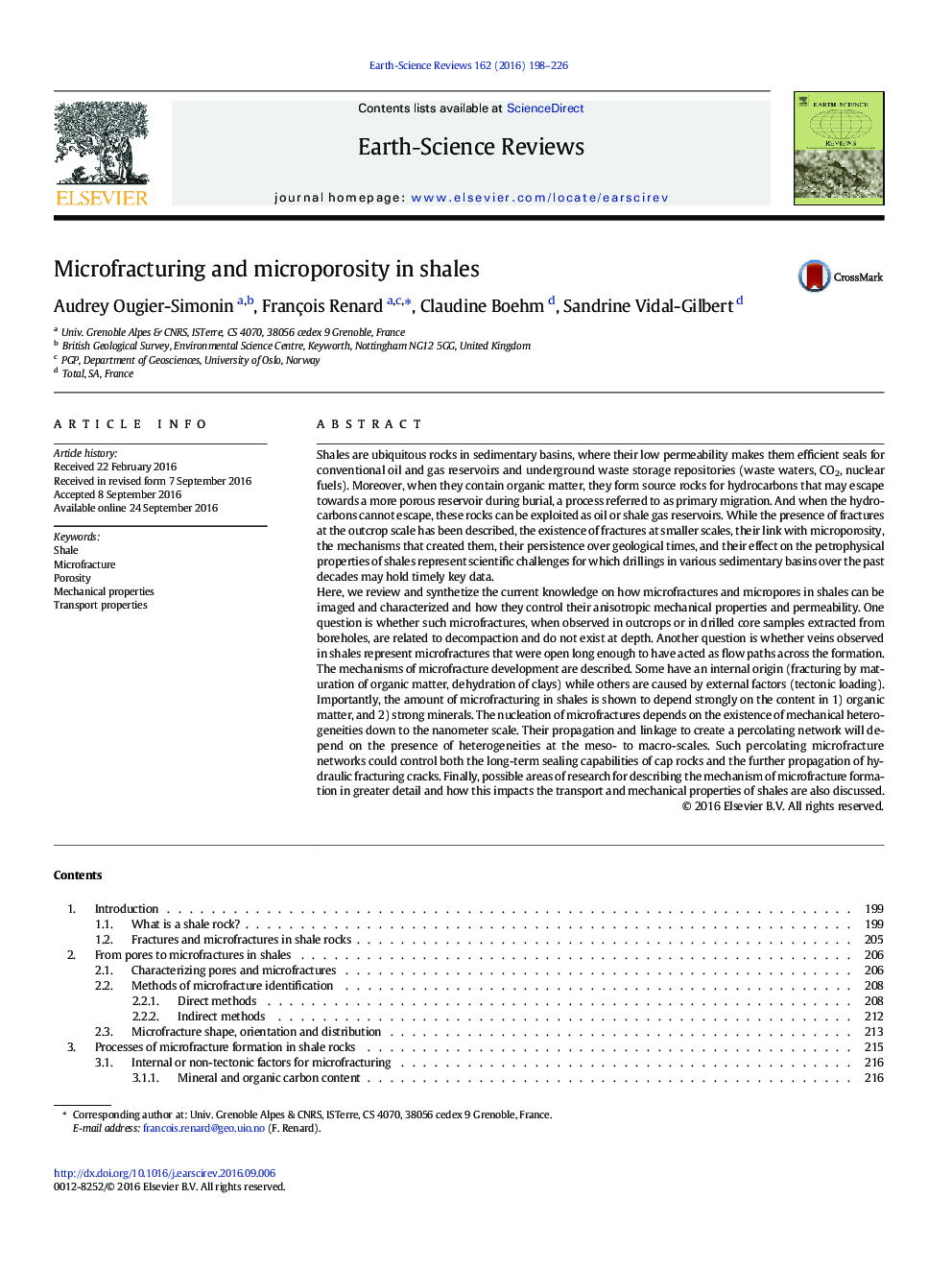| کد مقاله | کد نشریه | سال انتشار | مقاله انگلیسی | نسخه تمام متن |
|---|---|---|---|---|
| 6442767 | 1639940 | 2016 | 29 صفحه PDF | دانلود رایگان |
عنوان انگلیسی مقاله ISI
Microfracturing and microporosity in shales
ترجمه فارسی عنوان
میکرو فشرده سازی و میکروپوریته در شیل
دانلود مقاله + سفارش ترجمه
دانلود مقاله ISI انگلیسی
رایگان برای ایرانیان
کلمات کلیدی
شیل، میکروارگانیسم قطر بینی، ویژگی های مکانیکی، خواص حمل و نقل،
ترجمه چکیده
در اینجا، ما اطلاعات فعلی را در مورد نحوه تصویر برداری و مشخص شدن میکروارگانیسم ها و میکروپور ها در شیلات بررسی می کنیم و نحوه کنترل خواص مکانیکی آن ها و قابلیت نفوذ آنها را بررسی می کنیم. یک سوال این است که آیا چنین میکروفراکتوری ها، هنگامی که در پروتئین مشاهده شده یا در نمونه های هسته حفاری استخراج شده از گمانه ها، مربوط به تجزیه و در عمق وجود ندارد. سوال دیگر این است که آیا رگه ها در شیل ها مشاهده می شوند، نشان دهنده میکروارگانیسم هایی هستند که به اندازه کافی باز هستند تا به عنوان جریان های جریان در شکل گیری عمل کنند. مکانیسم توسعه میکروارگانیسم شرح داده شده است. برخی از آنها منشاء داخلی (شکسته شدن با بلوغ مواد آلی، کم آبی شدن رس ها) هستند، در حالی که دیگران به دلیل عوامل خارجی (بارگذاری تکتونیکی) ایجاد می شوند. بدیهی است که میزان میکروارگانیسم در شیل ها به شدت بستگی به محتوای 1) مواد آلی دارد و 2) مواد معدنی قوی. هسته ای میکروارگانیسم ها بستگی به وجود ناهمگونی مکانیکی به مقیاس نانومتری دارد. انتشار و پیوند آنها برای ایجاد یک شبکه پرکودن بستگی به وجود ناهمگونی در مقیاس های کوچک و بزرگ دارد. چنین شبکه های میکروارگانیایی پرکولاسیون می تواند هر دو توانایی دراز مدت بسته بندی سنگ های کپسول و انتشار بیشتر ترک های شکستگی هیدرولیکی را کنترل کند. در نهایت، زمینه های احتمالی تحقیق برای توصیف مکانیزم تشکیل میکروارگانیسم در جزئیات بیشتر و نحوه تاثیر این خواص بر روی انتقال و خواص مکانیکی شیلات نیز مورد بحث قرار گرفته است.
موضوعات مرتبط
مهندسی و علوم پایه
علوم زمین و سیارات
زمین شناسی
چکیده انگلیسی
Here, we review and synthetize the current knowledge on how microfractures and micropores in shales can be imaged and characterized and how they control their anisotropic mechanical properties and permeability. One question is whether such microfractures, when observed in outcrops or in drilled core samples extracted from boreholes, are related to decompaction and do not exist at depth. Another question is whether veins observed in shales represent microfractures that were open long enough to have acted as flow paths across the formation. The mechanisms of microfracture development are described. Some have an internal origin (fracturing by maturation of organic matter, dehydration of clays) while others are caused by external factors (tectonic loading). Importantly, the amount of microfracturing in shales is shown to depend strongly on the content in 1) organic matter, and 2) strong minerals. The nucleation of microfractures depends on the existence of mechanical heterogeneities down to the nanometer scale. Their propagation and linkage to create a percolating network will depend on the presence of heterogeneities at the meso- to macro-scales. Such percolating microfracture networks could control both the long-term sealing capabilities of cap rocks and the further propagation of hydraulic fracturing cracks. Finally, possible areas of research for describing the mechanism of microfracture formation in greater detail and how this impacts the transport and mechanical properties of shales are also discussed.
ناشر
Database: Elsevier - ScienceDirect (ساینس دایرکت)
Journal: Earth-Science Reviews - Volume 162, November 2016, Pages 198-226
Journal: Earth-Science Reviews - Volume 162, November 2016, Pages 198-226
نویسندگان
Audrey Ougier-Simonin, François Renard, Claudine Boehm, Sandrine Vidal-Gilbert,
